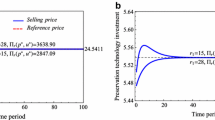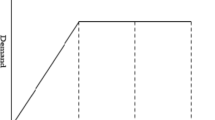Abstract
The food quality has always played an important role in the retail process since it has been considered as a direct factor to influence a consumer’s purchase decision. In this paper, we formulate an inventory model for perishable foods, in which the demand depends on the price and quality that decays continuously. The objective is to determine a joint dynamic pricing and preservation technology investment strategy while maximizing the total profit from selling a given initial inventory of foods. We first prove the existence of an optimal solution based on Filippov–Cesari theorem. Then, we obtain all the candidates and provide the conditions that make a certain candidate be an optimal solution according to Pontryagin’s maximum principle. Next, we present an effective algorithm to search for the optimal strategy. Finally, two numerical examples are employed to illustrate the solution procedure and the results, followed by sensitivity analysis and managerial insights.




Similar content being viewed by others
References
Adida, E., & Perakis, G. (2007). A nonlinear continuous time optimal control model of dynamic pricing and inventory control with no backorders. Naval Research Logistics, 54(7), 767–795.
Adida, E., & Perakis, G. (2010). Dynamic pricing and inventory control: Robust vs. stochastic uncertainty models-a computational study. Annals of Operations Research, 181(1), 125–157.
Akan, M., Ata, B., & Savaşkan-Ebert, R. C. (2013). Dynamic pricing of remanufacturable products under demand substitution: A product life cycle model. Annals of Operations Research, 211(1), 1–25.
Anjos, M. F., Cheng, R. C. H., & Currie, C. S. M. (2005). Optimal pricing policies for perishable products. European Journal of Operational Research, 166(1), 246–254.
Banerjee, P. K., & Turner, T. R. (2012). A flexible model for the pricing of perishable assets. Omega-International Journal of Management Science, 40(5), 533–540.
Broekmeulen, R. (1998). Operations management of distribution centers for vegetables and fruits. International Transactions in Operational Research, 5(6), 501–508.
Chatwin, R. E. (2000). Optimal dynamic pricing of perishable products with stochastic demand and a finite set of prices. European Journal of Operational Research, 125(1), 149–174.
Chenavaz, R. (2012). Dynamic pricing, product and process innovation. European Journal of Operational Research, 222(3), 553–557.
Chew, E. P., Lee, C., & Liu, R. (2009). Joint inventory allocation and pricing decisions for perishable products. International Journal of Production Economics, 120(1), 139–150.
Dye, C. Y., & Hsieh, T. P. (2012). An optimal replenishment policy for deteriorating items with effective investment in preservation technology. European Journal of Operational Research, 218(1), 106–112.
El Ouardighi, F., & Kogan, K. (2013). Dynamic conformance and design quality in a supply chain: An assessment of contracts’ coordinating power. Annals of Operations Research, 211(1), 137–166.
Ferguson, M., & Ketzenberg, M. E. (2006). Information sharing to improve retail product freshness of perishables. Production and Operations Management, 15(1), 57–73.
Geetha, K. V., & Uthayakumar, R. (2010). Economic design of an inventory policy for non-instantaneous deteriorating items under permissible delay in payments. Journal of Computational and Applied Mathematics, 233(10), 2492–2505.
Goyal, S. K., & Giri, B. C. (2001). Recent trends in modeling of deteriorating inventory. European Journal of Operational Research, 134(1), 1–16.
Gurnani, H., Erkoc, M., & Luo, Y. (2007). Impact of product pricing and timing of investment decisions on supply chain co-operation. European Journal of Operational Research, 180(1), 228–248.
Hartl, R. F., Sethi, S. P., & Vickson, R. G. (1995). A survey of the maximum principles for optimal control problems with state constraints. SIAM review, 37(2), 181–218.
Hong, J. D., & Hayya, J. C. (1995). Joint investment in quality improvement and setup reduction. Computers & Operations Research, 22(6), 567–574.
Hsieh, T. P., & Dye, C. Y. (2013). A production-inventory model incorporating the effect of preservation technology investment when demand is fluctuating with time. Journal of Computational and Applied Mathematics, 239, 25–36.
Hsu, P. H., Wee, H. M., & Teng, H. M. (2010). Preservation technology investment for deteriorating inventory. International Journal of Production Economics, 124(2), 388–394.
Jørgensen, S., & Zaccour, G. (1999). Equilibrium pricing and advertising strategies in a marketing channel. Journal of Optimization Theory and Applications, 102(1), 111–125.
Lee, H. H. (2008). The investment model in preventive maintenance in multi-level production systems. International Journal of Production Economics, 112(2), 816–828.
Lukasse, L. J. S., & Polderdijk, J. J. (2003). Predictive modelling of post-harvest quality evolution in perishables, applied to mushrooms. Journal of Food Engineering, 59(2), 191–198.
Maihami, R., & Kamalabadi, I. N. (2012). Joint pricing and inventory control for non-instantaneous deteriorating items with partial backlogging and time and price dependent demand. International Journal of Production Economics, 136(1), 116–122.
Mathur, P. P., & Shah, J. (2008). Supply chain contracts with capacity investment decision: two-way penalties for coordination. International Journal of Production Economics, 114(1), 56–70.
Nahmias, S. (1982). Perishable inventory theory: a review. Operations Research, 30(4), 680–708.
Péneau, S., Brockhoff, P. B., Escher, F., & Nuessli, J. (2007). A comprehensive approach to evaluate the freshness of strawberries and carrots. Postharvest Biology and Technology, 45(1), 20–29.
Rong, A., Akkerman, R., & Grunow, M. (2011). An optimization approach for managing fresh food quality throughout the supply chain. International Journal of Production Economics, 131(1), 421–429.
Seierstad, A., & Sydsæer, K. (1987). Optimal control theory with economic applications. Amsterdam: North-Holland.
Sethi, S. P., & Thompson, G. L. (2000). Optimal control theory: applications to management science and economics. Dordrecht, Netherlands: Kluwer.
Teng, J. T., & Thompson, G. L. (1996). Optimal strategies for general price-quality decision models of new products with learning production costs. European Journal of Operational Research, 93(3), 476–489.
Trienekens, J., & Zuurbier, P. (2008). Quality and safety standards in the food industry, developments and challenges. International Journal of Production Economics, 113(1), 107–122.
Vörös, J. (2006). The dynamics of price, quality and productivity improvement decisions. European Journal of Operational Research, 170(3), 809–823.
Wang, K. J., & Lin, Y. S. (2012). Optimal inventory replenishment strategy for deteriorating items in a demand-declining market with the retailer’s price manipulation. Annals of Operations Research, 201(1), 475–494.
Wang, X., & Li, D. (2012). A dynamic product quality evaluation based pricing model for perishable food supply chains. Omega-International Journal of Management Science, 40(6), 906–917.
Acknowledgments
This work was supported by National Natural Foundation of China Nos. 61004015, 71371133, and the Program for New Century Excellent Talents in Universities of China No. NCET-11-0377.
Author information
Authors and Affiliations
Corresponding author
Rights and permissions
About this article
Cite this article
Liu, G., Zhang, J. & Tang, W. Joint dynamic pricing and investment strategy for perishable foods with price-quality dependent demand. Ann Oper Res 226, 397–416 (2015). https://doi.org/10.1007/s10479-014-1671-x
Published:
Issue Date:
DOI: https://doi.org/10.1007/s10479-014-1671-x




